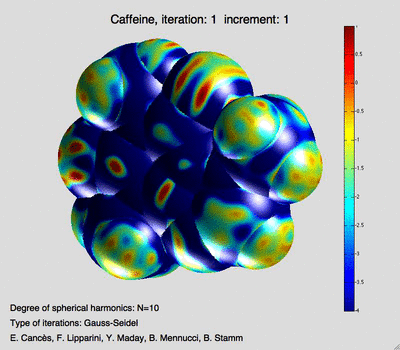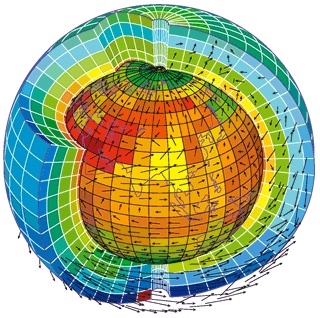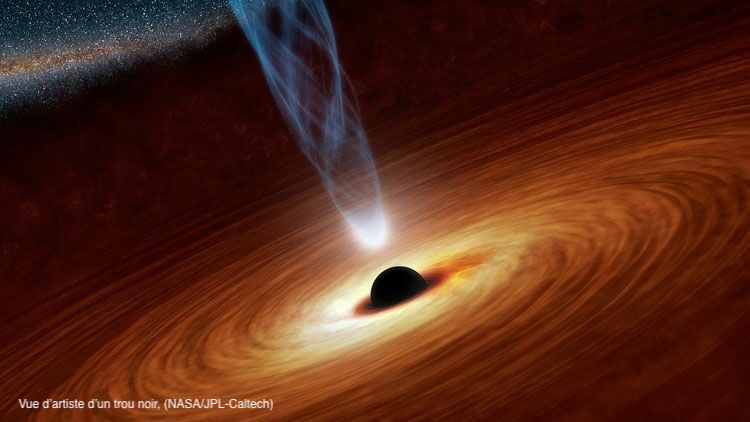Applications to physics, chemistry, mechanics and engineering





The activities of the Jacques-Louis Lions Laboratory can also be presented from the point of view of their applications, which are numerous and cover all the scales involved in theoretical and applied physics. We present here a non-exhaustive panel of representative results.
Quantum chemistry
Main results
Mi-Song Dupuy, Eric Cancès and Xavier Blanc have developed methods for calculating electronic structures using plane wave bases augmented with functions that precisely describe the singularities of the wave functions. Yvon Maday and his colleagues have obtained a series of results on a posteriori error analysis for nonlinear eigenvalue problems such as those encountered in electronic structure calculation (Hartree Fock or Kohn-Sham. Pierre Monmarché has developed stochastic algorithms for sampling biological chemistry systems, in collaboration with chemists and physicists for molecular dynamics.
Current prospects
The adaptive algorithms developed by Pierre Monmarché in molecular dynamics have reached a level of maturity where they can be applied to high-dimensional non-convex problems in other fields, notably neural network optimization in deep learning.
Mi-Song Dupuy would like to study two new aspects of numerical simulation of chemical systems. The first deals with the analysis of time-dependent density functional theory (TDDFT), which aims to efficiently calculate the excited states of an electronic system. A second section focuses on tensor networks for high-dimensional problems, including the question of quantum computer supremacy.

Fluid mechanics
Main results
Xavier Blanc has studied the effect of intense radiation on the development of hydrodynamic instabilities in stellar flows in the regime of a small Péclet number. Frédérique Charles and her colleagues are interested in the evolution of particles (such as solid dust particles or droplets) in a rarefied gas. The interaction between the gas and the dust particles is modeled by a free transport equation in a moving domain.
Current prospects
Jacques Sainte-Marie’s work led to the development of the Freshkiss3d numerical code for solving free-surface Navier-Stokes equations (see [24] [24] and https://freshkiss3d.gitlabpages.inria.fr). This tool is very useful for interacting with oceanographers and improving numerical codes used operationally, in particular the NEMO code https://www.nemo-ocean.eu/. This will be a major focus of research in the years to come.

Solids modeling
Main results
Hervé Le Dret has revisited the fundamentals of continuum thermodynamics and the mathematical modeling of thermo-visco-elastic materials with or without internal variables. Stéphane Labbé has developed atomic models of ferromagnetic materials to understand temperature phenomena and their integration into micro-magnetic mesoscopic models.

General relativity
Main results
Philippe LeFloch studies the stability of general relativity spacetimes. In collaboration with his former PhD student Yue Ma, for Einstein’s equations coupled with a massive field, such as a scalar Klein-Gordon field. Jérémie Szeftel is interested in the stability conjecture for Kerr black holes, which form a family of explicit stationary solutions to Einstein’s vacuum equations corresponding to rotating black holes. Jacques Smulevici has demonstrated the existence of stationary solutions in geometries representing axisymmetric black holes, using kinetic theory tools.

Current prospects
The laboratory’s work on mathematical general relativity continues to expand. In particular, Philippe LeFloch has launched a new research theme on constraints (Hamiltonian, moment) associated with Einstein equations, for which he is developing new geometric analysis techniques for non-linear elliptic PDEs.

